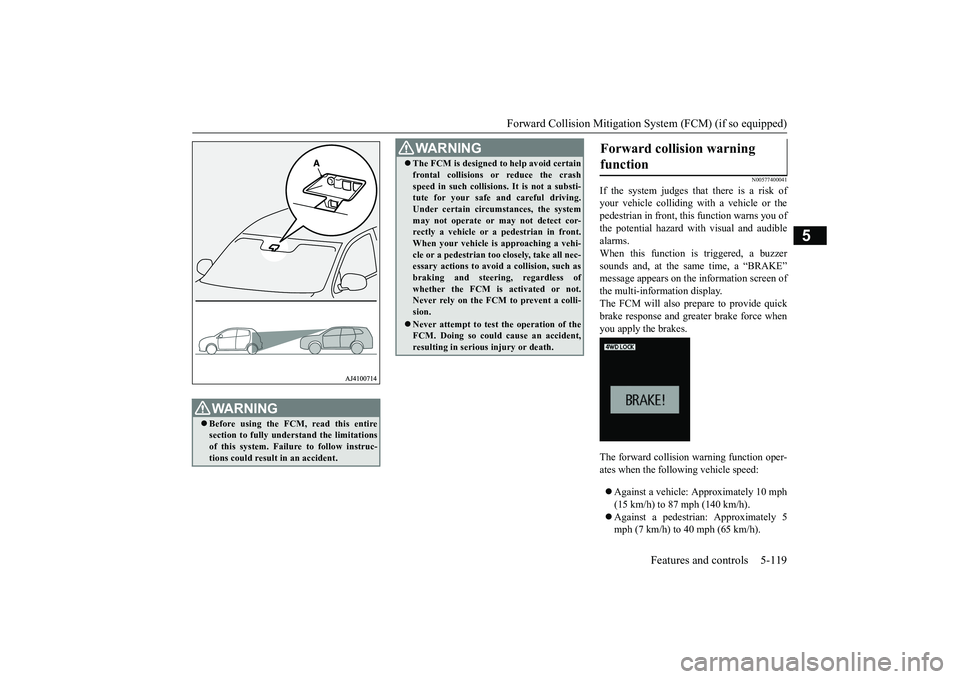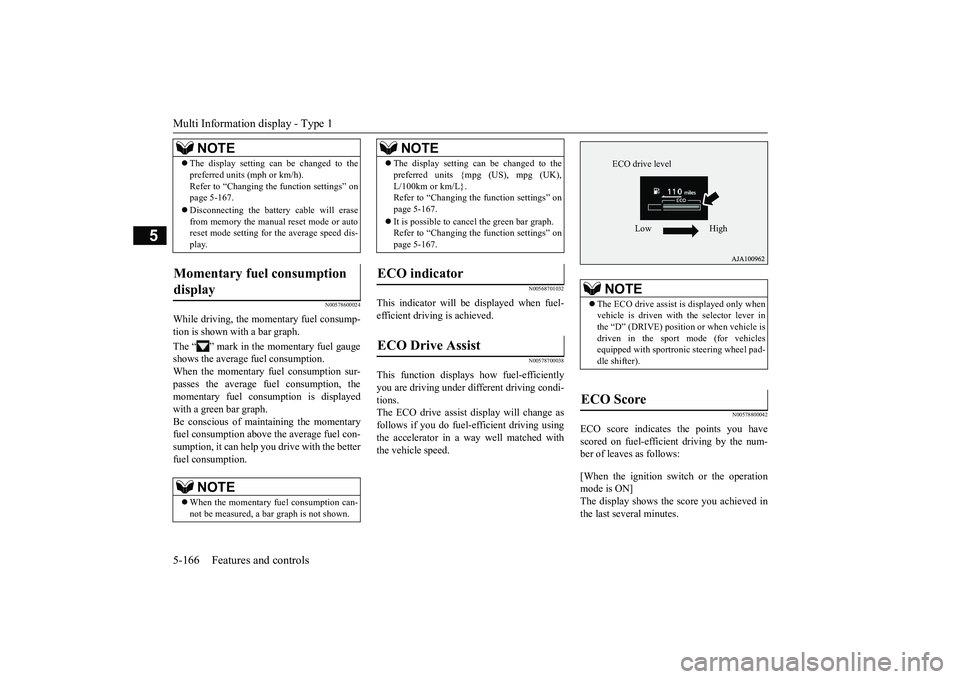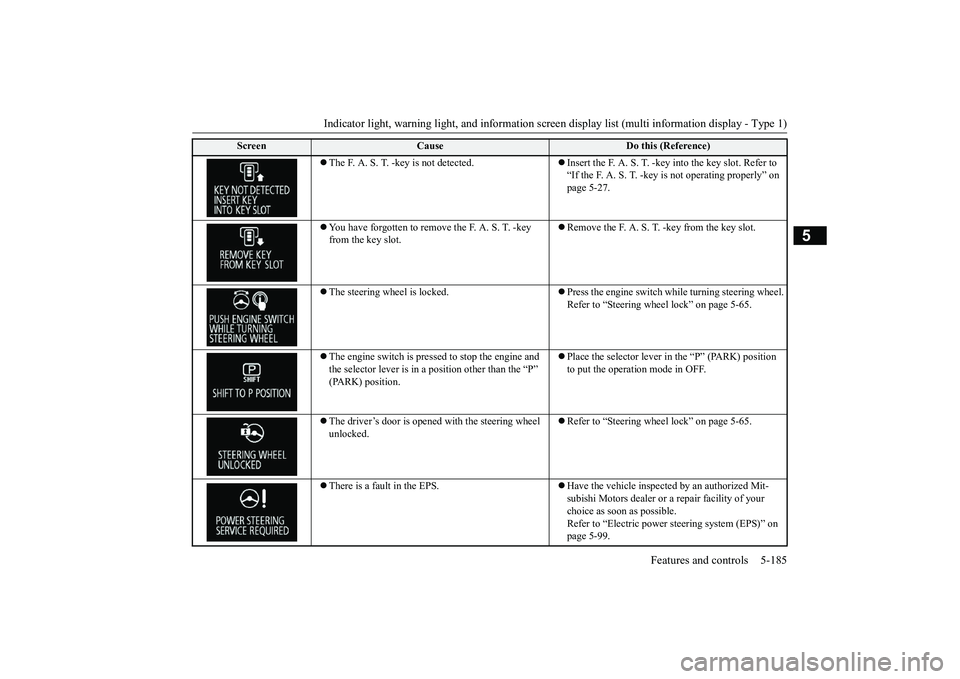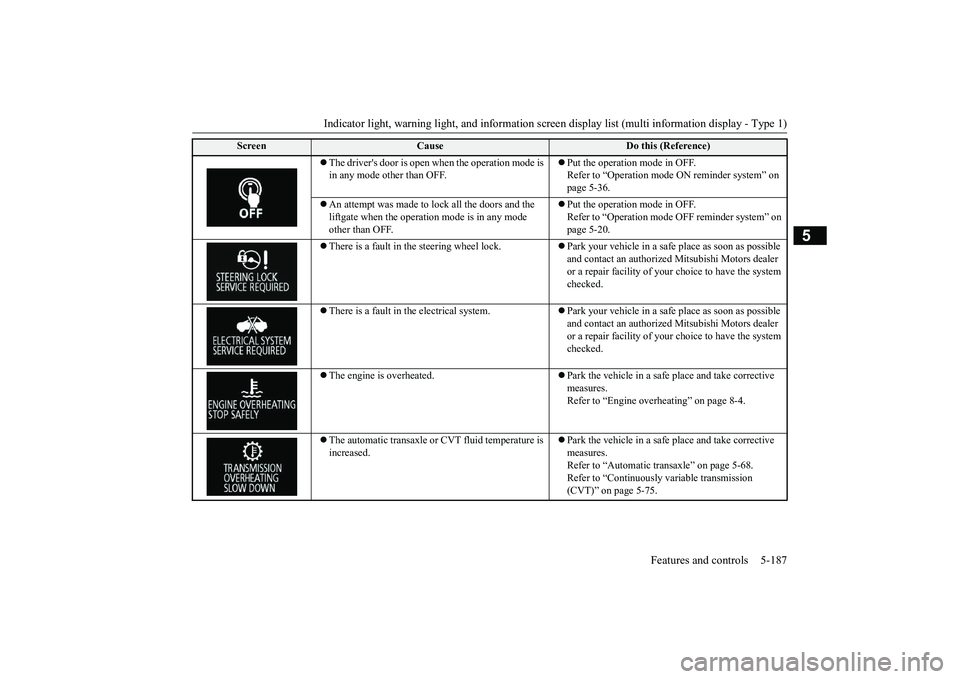2018 MITSUBISHI OUTLANDER III steering
[x] Cancel search: steeringPage 200 of 441

Forward Collision Mitigation System (FCM) (if so equipped)
Features and controls 5-119
5
N00577400041
If the system judges that there is a risk ofyour vehicle colliding wi
th a vehicle or the
pedestrian in front, th
is function warns you of
the potential hazard with
visual and audible
alarms.When this function is triggered, a buzzersounds and, at the same time, a “BRAKE”message appears on the information screen ofthe multi-information display.The FCM will also prepare to provide quickbrake response and greater brake force whenyou apply the brakes.The forward collision
warning function oper-
ates when the following vehicle speed:Against a vehicle: Approximately 10 mph(15 km/h) to 87 mph (140 km/h).Against a pedestrian
: Approximately 5
mph (7 km/h) to 40 mph (65 km/h).
WA R N I N GBefore using the FCM, read this entiresection to fully understand the limitationsof this system. Failure to follow instruc-tions could result
in an accident.
The FCM is designed
to help avoid certain
frontal collisions or reduce the crashspeed in such collisions. It is not a substi-tute for your safe and careful driving.Under certain circumstances, the systemmay not operate or may not detect cor-rectly a vehicle or a
pedestrian in front.
When your vehicle is
approaching a vehi-
cle or a pedestri
an too closely, take all nec-
essary actions to avoi
d a collision, such as
braking and
steering, regardless of
whether the FCM is
activated or not.
Never rely on the FCM to prevent a colli-sion.Never attempt to test the operation of theFCM. Doing so could cause an accident,resulting in seriou
s injury or death.
WA R N I N G
Forward collision warning function
BK0249100US.book 119 ページ 2017年5月10日 水曜日 午前8時49分
Page 202 of 441

Forward Collision Mitigation System (FCM) (if so equipped)
Features and controls 5-121
5
• When the system recognizes driver’ssteering, accelerati
ng, braking or gear
shifting actions as
evasive actions to
avoid collision.• When the rear of your vehicle is weigheddown with the weight of passengers andluggage.• Up to several seconds after starting driv-ing.• In adverse weather conditions, such asrain, snow, fog or sand-storm.• When the windshield of the sensor por-tion is covered with dirt, water droplets,snow and ice, etc.• When a vehicle ahea
d or an oncoming
vehicle is splashing wa
ter, snow or dirt.
• When using a windshield washer.• If windshield wipers are not MitsubishiMotors Genuine parts or equivalent. • When the sensor becomes extremely hotor cold.• If the battery becomes weak or runsdown.• When the sensor is affected by stronglight, such as direct
sunlight or the head-
lights of an oncoming vehicle.
The FCM may not detect a pedestrian incertain situations. Some of these include:• If the pedestrian is
shorter than approxi-
mately 3.2 feet (1 m) or taller thanapproximately 6.5 feet (2 m).WA R N I N G
• If the pedestrian is wearing loose-fittingclothes.• If part of a pedestrian’s body is hidden,such as when holding an umbrella, largebag, etc.• If a pedestrian bends forward, sits or lieson the road.• When a pedestrian is pushing/pullingsomething, such as a stroller, bicycle orwheelchair.• When pedestrians gather in a group.• When a pedestrian
clothing appears to
be nearly the same color or brightness asits surroundings.• When a pedestrian is very close to anobject, such as a vehicle.• When a pedestrian is in a dark area, suchas at night or in a tunnel.• When a pedestrian is walking fast orrunning.• When a pedestrian suddenly rushes infront of the vehicle.• When the position of
a pedestrian is close
to the edge of the vehicle.
When the system recognizes driver’ssteering or accelerati
ng actions as evasive
actions to avoid a collision, FCM controland alarm functions
may be canceled.
In certain situations, though there is littleor no risk of a collision, the FCM mayactivate. Examples include: • When overtaking a vehicle.WA R N I N G
• When driving on a curve.
Page 221 of 441

Tire pressure monitoring system5-140 Features and controls
5
allow the TPMS to cont
inue to function prop-
erly.
N00532801511
1. If the tire pressure monitoring systemwarning light illuminates, avoiding hardbraking, sharp steering maneuvers andhigh speeds. You should stop and adjustthe tires to the proper inflation pressure assoon as possible. Adjust the spare tire atthe same time. Refer to “Tires” on page9-15.
2. If the tire pressure monitoring systemwarning light remain
s illuminated after
you have been driving for about 20 min-utes after you adjust the tire inflation pres-sure, one or more of the tires may have apuncture. Inspect the tire and if it has apuncture, have it repaired by an autho-rized Mitsubishi Motors dealer as soon aspossible.
The tire pressure monitoring system may notwork normally in the following circum-stances:A wireless facility
or device using the
same frequency is near the vehicle.Snow or ice is stuck inside the fendersand/or on the wheels.The tire inflation pressure sensor’s batteryis dead.Wheels other than Mitsubishi genuinewheels are being used.Wheels that are not fitted with tire infla-tion pressure sensors are being used.Wheels whose ID codes are not memo-rized by the vehicle are used.Compact spare tire is fitted as a roadwheel.
If the warning light / display illuminates while driving
NOTE
In addition, the warni
ng display is displayed
on the information screen in the multi-infor-mation display.When inspecting or adjusting the tire pres-sure, do not apply excessive force to thevalve stem to
avoid breakage.
After inspecting or adjusting the tire pres-sure, always reinstall the valve cap on thevalve stem.Without the valve cap, di
rt or moisture could
get into the valve, resulting in damage to thetire inflation pressure sensor.Do not use metal valve caps, which maycause a metal reaction,
resulting in corrosion
and damage of the tire
inflation pressure sen-
sors.
Once adjustments have
been made, the warn-
ing light will go off after a few minutes ofdriving.WA R N I N GIf the warning light
/ display illuminates
while you are driving, avoid hard braking,sharp steering maneuvers and highspeeds.Driving with an under-inflated tireadversely affects vehi
cle performance and
can result in an accident.CAUTIONIf a tire has a puncture, replace that tire withthe spare tire. Driving on a punctured tirecould lead to an accident.The warning light / di
splay may not illumi-
nate immediately in the
event of a tire blow-
out or rapid leak.NOTE
NOTE
To avoid the risk of damage to the tire infla-tion pressure sensors, have any puncturedtire repaired by an authorized MitsubishiMotors dealer. If the tire repair is not done byan authorized Mitsubishi Motors dealer, it isnot covered by your warranty.Do not use an aerosol puncture-repair sprayon any tire.Such a spray could dama
ge the tire inflation
pressure sensors.Have any puncture repa
ired by an authorized
Mitsubishi Motors dealer.
BK0249100US.book 140 ページ 2017年5月10日 水曜日 午前8時49分
Page 230 of 441

Multi Around Monitor (if so equipped)
Features and controls 5-149
5
If the camera switch is pressed, the mode ofMulti Around Monitor is switched, Bird’seye-view/Rear-view mode
Side-
view/Rear-view modeIf the camera switch is pressed, the mode ofMulti Around Monitor is switched, Bird’seye-view/Front-view mode
Side-
view/Front-view mode
OFF
N00587600033
In any mode other than the Bird’s eye-viewmode, the lines in the screen give the follow-ing information. Use them only as a guide.
Reference lines for the
distance and the vehi-
cle width and upper surface of the front bum-per (A) are displayed on the screen.The Red line (B) i
ndicates approximately
20 inches (50 cm) from the front edge ofthe front bumper.The Two Green lines (C) indicate theapproximate vehicle width.The Orange lines (D) indicates anexpected course when the vehicle movesforward with the steering wheel turned. Itdisappears when the steering wheel is inthe neutral position.The approximate distance from the vehi-cle body is as follows:
NOTE
If there is no operation for 3 minutes afterthe Multi Around Monitor is displayed bypressing the switch with the selector lever inother than “R” (REVERSE), the display dis-appears.
Switching of the screen (Selector lever is “R” (REVERSE))
Switching of the screen (Selector lever is other than “R”
NOTE
When you move the selector lever to the “R”mode displayed on the driver’s side screen,the driver’s side screen switches to the rear-view mode. When you shift the selector leverto any other position, the driver’s side screenswitches to the front-view mode.When the camera switch is pressed at thevehicle speed of appr
oximately 6 mph (10
km/h) or higher, only
the side-view can be
displayed on the passenger’s side screen.The front-view will not
be displayed when
the vehicle speed exce
eds approximately 6
mph (10 km/h).The display of the view
may be delayed dur-
ing switching of the screen.
How to read the screen
CAUTIONIf the camera and/or its surrounding areahave experienced an impact, the MultiAround Monitor system may not functioncorrectly. Have the vehicle inspected by anauthorized Mitsubish
i Motors dealer.
Front-view mode
BK0249100US.book 149 ページ 2017年5月17日 水曜日 午後2時31分
Page 231 of 441

Multi Around Monitor (if so equipped)
5
N00587700021
Reference lines for the
distance and the vehi-
cle width and upper surface of the rear bum-per (A) are displayed on the screen.The Red line (B) i
ndicates approximately
20 inches (50 cm) behind the rear edge ofthe rear bumper.The Two Green lines (C) indicate theapproximately vehicle width.The Orange line (D) indicates an expectedcourse when the vehicle is reserved withthe steering wheel turned. It disappearswhen the steering wheel is in the neutralposition.The approximate distance from the vehi-cle body is as follows:
1- Approximately 39 inches (100 cm) from
the front edge of the front bumperNOTE
When the expected course lines are dis-played in the front-view, the expected courselines are also displayed in the bird’s eye-view (Front: solid li
ne, Rear: broken line).
Rear-view mode
1- Approximately 39 inches (100 cm)
from the rear edge of the rear bumper
2- Approximately 79 inches (200 cm)
from the rear edge of the rear bumperCAUTIONThe rear-view camera uses a wide-anglelens. As a result, imag
es and distances shown
on the screen are not exact.Never rely solely on the reference lines. Thereference lines indicati
ng distance and vehi-
cle width are based on a
level, flat road sur-
face.Actual distance may be
different from dis-
tance indica
ted by the lines on the screen,
depending on the loading condition of thevehicle and road
surface condition.
Also, your vehicle wi
dth indicated by the
reference lines may be different from theactual vehicle width.For example;In the following cases, objects shown on thescreen will appear to be farther off than theyactually are.
BK0249100US.book 150 ページ 2017年5月10日 水曜日 午前8時49分
Page 247 of 441

Multi Information display - Type 15-166 Features and controls
5
N00578600024
While driving, the momentary fuel consump-tion is shown with a bar graph.The “ ” mark in the momentary fuel gaugeshows the average fuel consumption.When the momentary fuel consumption sur-passes the average fuel consumption, themomentary fuel consumption is displayedwith a green bar graph.Be conscious of maintaining the momentaryfuel consumption above the average fuel con-sumption, it can help you drive with the betterfuel consumption.
N00568701032
This indicator will be displayed when fuel-efficient driving is achieved.
N00578700038
This function displays
how fuel-efficiently
you are driving under different driving condi-tions.The ECO drive assist display will change asfollows if you do fuel-efficient driving usingthe accelerator in a way well matched withthe vehicle speed.
N00578800042
ECO score indicates the points you havescored on fuel-efficient driving by the num-ber of leaves as follows:[When the ignition switch or the operationmode is ON]The display shows the score you achieved inthe last several minutes.
The display setting can be changed to thepreferred units (mph or km/h).Refer to “Changing th
e function settings” on
page 5-167.Disconnecting the batt
ery cable will erase
from memory the manual reset mode or autoreset mode setting for the average speed dis-play.
Momentary fuel consumption display
NOTE
When the momentary fuel consumption can-not be measured, a ba
r graph is not shown.
NOTE
The display setting can be changed to thepreferred units {mpg (US), mpg (UK),L/100km or km/L}.Refer to “Changing the
function settings” on
page 5-167.It is possible to cancel the green bar graph.Refer to “Changing the
function settings” on
page 5-167.
ECO indicator ECO Drive Assist
NOTE
NOTE
The ECO drive assist is displayed only whenvehicle is driven with
the selector lever in
the “D” (DRIVE) positi
on or when vehicle is
driven in the sport mode (for vehiclesequipped with sportroni
c steering wheel pad-
dle shifter).
ECO Score
ECO drive level
Low High
BK0249100US.book 166 ページ 2017年5月10日 水曜日 午前8時49分
Page 266 of 441

Indicator light, warning light, and information screen display list (multi information display - Type 1)
Features and controls 5-185
5
The F. A. S. T. -key is not detected.
Insert the F. A. S. T. -key into the key slot. Refer to “If the F. A. S. T. -key
is not operating properly” on
page 5-27.
You have forgotten to remove
the F. A. S. T. -key
from the key slot.
Remove the F. A. S. T.
-key from the key slot.
The steering wheel is locked.
Press the engine switch wh
ile turning steering wheel.
Refer to “Steering wheel lock” on page 5-65.
The engine switch is pre
ssed to stop the engine and
the selector lever is in a position other than the “P”
Place the selector lever in
the “P” (PARK) position
to put the operati
on mode in OFF.
The driver’s door is opened with the steering wheel unlocked.
Refer to “Steering wheel lock” on page 5-65.
There is a fault in the EPS.
Have the vehicle inspected by an authorized Mit-subishi Motors dealer or a
repair facility of your
choice as soon as possible.Refer to “Electric power
steering system (EPS)” on
page 5-99.
Screen
Cause
Do this (Reference)
BK0249100US.book 185 ページ 2017年5月10日 水曜日 午前8時49分
Page 268 of 441

Indicator light, warning light, and information screen display list (multi information display - Type 1)
Features and controls 5-187
5
The driver's door is open when the operation mode is in any mode other than OFF.
Put the operation mode in OFF.Refer to “Operation mode
ON reminder system” on
page 5-36.
An attempt was made to lock all the doors and the liftgate when the operati
on mode is in any mode
other than OFF.
Put the operation mode in OFF.Refer to “Operation mode
OFF reminder system” on
page 5-20.
There is a fault in the steering wheel lock.
Park your vehicle in a safe
place as soon as possible
and contact an authorized
Mitsubishi Motors dealer
or a repair facility of your
choice to have the system
checked.
There is a fault in the electrical system.
Park your vehicle in a safe
place as soon as possible
and contact an authorized
Mitsubishi Motors dealer
or a repair facility of your
choice to have the system
checked.
The engine is overheated.
Park the vehicle in a safe place and take corrective measures.Refer to “Engine overh
eating” on page 8-4.
The automatic transaxle or CVT fluid temperature is increased.
Park the vehicle in a safe place and take corrective measures.Refer to “Automatic tr
ansaxle” on page 5-68.
Refer to “Continuously variable transmission (CVT)” on page 5-75.
Screen
Cause
Do this (Reference)
BK0249100US.book 187 ページ 2017年5月10日 水曜日 午前8時49分